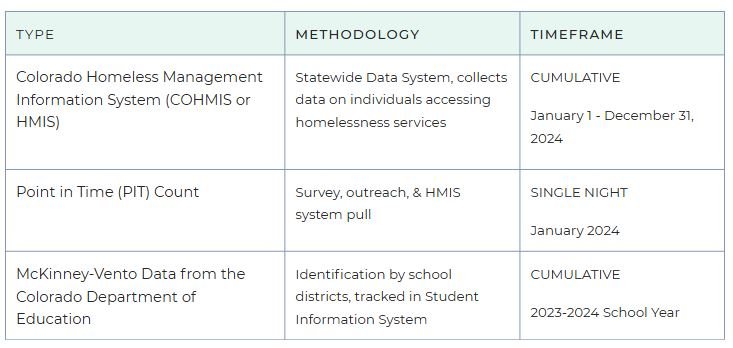Data Sources
Homelessness continues to be one of the most pressing challenges in Colorado and across the country. Data is central to understanding and solving this issue. The State of Homelessness report synthesizes several data sources along with input from people with lived experience to comprehensively depict homelessness in Colorado. The methodology, time frame, and definition of homelessness vary by data source.
Important Data Considerations & Limitations
The COHMIS Leads from each CoC are constantly looking at ways to improve our dashboards to ensure the metrics are as accessible and straightforward as possible. Homeless service data is complex and requires nuanced interpretation. We highly recommend that you visit the Definitions page before analyzing the data available on these dashboards.
Please be respectful as your view these dashboards as they represent people in our communities.
Do not use information from these dashboards in publications without first contacting the COHMIS Lead agencies to ensure you are interpreting information correctly. You can contact the COHMIS Leads by submitting a ticket at our Helpdesk.
Limitations
This report synthesizes the current information available regarding homelessness in the region. However, as with any data surrounding the issue of homelessness, there are several key limitations. The data does not provide “apple-to-apple” comparisons across sources. Comparison is not possible nor advised. Significant differences in counts do appear; however, each of these data sets is unique in what, who, and how it measures homelessness. When combined, they create a much broader understanding of homelessness in our community.
Different Definitions of Homelessness
Two definitions of homelessness are used for this report, provided by the US Department of Housing and Urban Development (HUD) and the US Department of Education.
Different Timeframes and Methodologies
The Point in Time takes place on a single night; HMIS data are cumulative 2024 calendar year; and the Mc-Kinney Vento data is from the last reported school year (23-24). Each of these sources has different methodologies and reporting requirements for data collection.
Duplicate Profiles
These dashboards reflect the unique count of Client & Household Identifiers associated with people having their information entered into COHMIS. However, we know there are a number of duplicate profiles due to data collection challenges associated with homeless services. COHMIS Leads regularly monitor the system for duplicate profiles, merging them as they are identified, but it is likely the overall numbers reflected in these dashboards are impacted by these records.
Within the dashboards the total number of people and households served uses an unduplicated count. When reviewing Project Type (i.e. emergency shelters, housing, etc.) these are unduplicated counts per type but are duplicated counts across all projects as households can access multiple projects at any given time.
Underrepresented Populations
Agencies designated as Victim Service Providers (VSPs) who serve people fleeing domestic violence are prevented by law from entering personally identifying information about these participants into HMIS. These providers are generally required to use an HMIS Domestic Violence Comparable Database. Due to these requirements, we are unable to reflect the persons being served at VSP organizations in our COHMIS dashboards.
Not Exhaustive on the Topic of Homelessness
This report is a mechanism to inform the public, lawmakers, and our local provider community on the wider issue of homelessness in order to improve collaboration throughout the region. It is not exhaustive.
Sources
Additional Sources and Information
Colorado Coalition for the Homeless: Older Adults & Homelessness Issue Brief 2025
Colorado Courts: Eviction Legal Defense Fund Five-Year Evaluation, December 2024, and Residential Eviction Data
Colorado Department of Local Affairs: Emergency Rental Assistance, Built for Zero Colorado Statewide Snapshot, and Tenancy Support Services Report
Colorado Homeless Management Information System (COHMIS): Helpdesk & Resources
Colorado Housing Connects: Colorado Statewide Insight Report
Colorado Springs Pro-Housing Partnership: Homeless Union
Colorado’s Statewide Supportive Housing Expansion: SWSHE
Community Solutions: Colorado Implements Statewide Model with Built for Zero, Built for Zero (BFZ), Functional Zero, Fremont County, and Metro Denver Achieves Quality Data
Corporation for Supportive Housing (CSH): Supportive Housing-Cost Benefit Analysis
Department of Local Affairs (DOLA) : Annual Public Report on Funding of Affordable Housing Preservation and Production
Douglas County: Achieves Functional Zero for Veterans, ensuring homelessness is rare and brief
Fair Market Rent: FY 2025 Documentation System
Housing and Urban Development: HMIS, Point-in-Time, Coordinated Entry, Housing Inventory Count: 2020, 2021, 2022, 2023 and 2024, and Housing First in Permanent Supportive Housing
Legal Services Corporation - Civil Court Data Initiative: Colorado Trends in Eviction Filings
McKinney-Vento: Colorado Department of Education
National Alliance to End Homelessness - State of Homelessness: Colorado, 2023 Doubled Up and Sever Housing Cost Burden by State, and Renter & Severe Housing Cost Burden Racial Disparities
National Coalition for the Homeless: Homelessness Among the LDBTQ Community
National Low Income Housing Coalition: Colorado Affordable Rent, Colorado Housing Gap, and Housing Access for Immigrant Households
National Network to End Domestic Violence: Housing Needs of Survivors of Domestic Violence, Dating Violence, and Stalking
Substance Abuse and Mental Health Services Administration (SAMHSA): Permanent Supportive Housing Evidence-Based Practices
United States Interagency Council on Homelessness: Homelessness Prevention Series: Spotlight on the Jail-to-Homelessness Pipeline
University of Colorado Anschutz Medical Campus: Many More Denver Teens Have Experienced Homelessness Than Official Counts Show
Urban Institute: Denver Supportive Housing Social Impact Bond Initiative
U.S. Department of the Treasury: Emergency Rental Assistance Program
Western Center on Law & Poverty: Addressing Disparities in Housing - Indigenous Population Solutions

